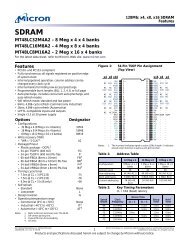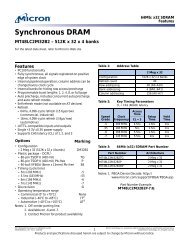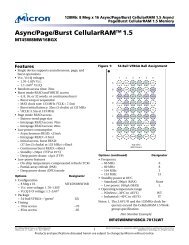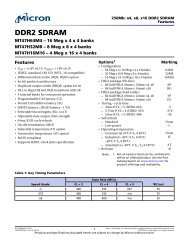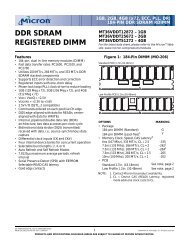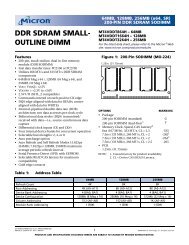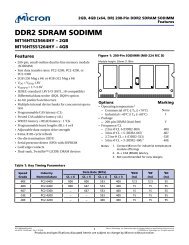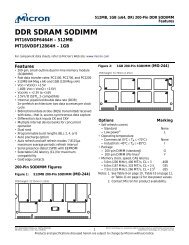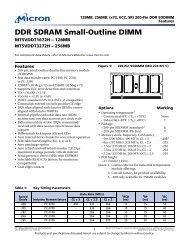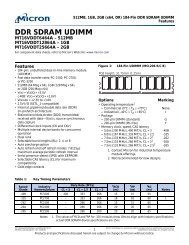TN 47-02: Calculating Memory System Power for DDR2 - Micron
TN 47-02: Calculating Memory System Power for DDR2 - Micron
TN 47-02: Calculating Memory System Power for DDR2 - Micron
Create successful ePaper yourself
Turn your PDF publications into a flip-book with our unique Google optimized e-Paper software.
Technical Note<br />
<strong>Calculating</strong> <strong>Memory</strong> <strong>System</strong> <strong>Power</strong> <strong>for</strong> <strong>DDR2</strong><br />
Introduction<br />
DRAM Operation<br />
<strong>TN</strong>-<strong>47</strong>-04: <strong>Calculating</strong> <strong>Memory</strong> <strong>System</strong> <strong>Power</strong> <strong>for</strong> <strong>DDR2</strong><br />
Introduction<br />
This technical note details how <strong>DDR2</strong> SDRAM consumes power, and it provides the tools<br />
system designers need to estimate power consumption in a given system. In addition to<br />
offering tools and techniques <strong>for</strong> calculating system power, examples are provided,<br />
including <strong>Micron</strong>’s <strong>DDR2</strong>-533 “Data Sheet Specifications” on page 18 and “<strong>System</strong><br />
Examples” on page 19.<br />
To estimate the power consumption of a <strong>DDR2</strong> SDRAM, it is necessary to understand the<br />
basic functionality of the device (see Figure 1). The basic operation of a <strong>DDR2</strong> device is<br />
similar to that of a DDR device. For both, the master operation of the DRAM is controlled<br />
by clock enable (CKE).<br />
Figure 1: 256Mb <strong>DDR2</strong> SDRAM Functional Block Diagram<br />
CKE<br />
CK#<br />
CK<br />
CS#<br />
WE#<br />
CAS#<br />
RAS#<br />
A0-A12,<br />
BA0, BA1<br />
15<br />
COMMAND<br />
DECODE<br />
CONTROL<br />
LOGIC<br />
MODE REGISTERS<br />
ADDRESS<br />
REGISTER<br />
15<br />
REFRESH<br />
COUNTER<br />
13<br />
10<br />
2<br />
13<br />
ROW-<br />
ADDRESS<br />
MUX<br />
2<br />
13<br />
BANK<br />
CONTROL<br />
LOGIC<br />
COLUMN-<br />
ADDRESS<br />
COUNTER/<br />
LATCH<br />
BANK 0<br />
ROW-<br />
ADDRESS<br />
LATCH 8,192<br />
&<br />
DECODER<br />
9<br />
1<br />
BANK 3<br />
BANK 2<br />
BANK 1<br />
BANK 0<br />
MEMORY<br />
ARRAY<br />
(8,192 x 512 x 16)<br />
SENSE AMPLIFIERS<br />
8,192<br />
I/O GATING<br />
DM MASK LOGIC<br />
512<br />
(x16)<br />
COLUMN<br />
DECODER<br />
09005aef812507c7/09005aef81257459 <strong>Micron</strong> Technology, Inc., reserves the right to change products or specifications without notice.<br />
<strong>TN</strong><strong>47</strong>04.fm - Rev. A 6/27/06 EN 1 ©2005 <strong>Micron</strong> Technology, Inc. All rights reserved.<br />
Products and specifications discussed herein are <strong>for</strong> evaluation and reference purposes only and are subject to change by<br />
<strong>Micron</strong> without notice. Products are only warranted by <strong>Micron</strong> to meet <strong>Micron</strong>’s production data sheet specifications. All<br />
in<strong>for</strong>mation discussed herein is provided on an “as is” basis, without warranties of any kind.<br />
16<br />
16<br />
16<br />
READ<br />
LATCH<br />
8<br />
8<br />
WRITE<br />
FIFO<br />
&<br />
DRIVERS<br />
clk<br />
out<br />
CK<br />
clk<br />
in<br />
MUX<br />
COL0<br />
MASK<br />
2<br />
16<br />
DATA<br />
COL0<br />
8<br />
INPUT<br />
REGISTERS<br />
1<br />
1<br />
1<br />
8<br />
8<br />
DQS<br />
GENERATOR<br />
1<br />
8<br />
8<br />
DATA<br />
1<br />
1<br />
8<br />
CK<br />
DLL<br />
DRVRS<br />
DQS<br />
1<br />
RCVRS<br />
DQ0–<br />
DQ7<br />
DQS<br />
DM
DRAM <strong>Power</strong> Calculations<br />
Background <strong>Power</strong><br />
<strong>TN</strong>-<strong>47</strong>-04: <strong>Calculating</strong> <strong>Memory</strong> <strong>System</strong> <strong>Power</strong> <strong>for</strong> <strong>DDR2</strong><br />
DRAM <strong>Power</strong> Calculations<br />
If CKE is LOW, the <strong>DDR2</strong> clock and input buffers are turned off. However, to communicate<br />
with the device, CKE must be HIGH, which enables the inputs and propagates the<br />
clock through the DRAM.<br />
With CKE HIGH, commands can be sent to the <strong>DDR2</strong> device. Typically, the first<br />
command (after the initialization) is ACTIVATE (ACT). This command selects a bank and<br />
row address and transfers the row’s cell data, which is stored in the array, to the sense<br />
amplifiers, putting the device in the active state. The data stays in the sense amplifiers<br />
until a PRECHARGE (PRE) command to the same bank restores the data to the cells in<br />
the array, putting the device in the precharge state.<br />
In the active state, the <strong>DDR2</strong> device can per<strong>for</strong>m READs and WRITEs. A READ command<br />
decodes a specific column along the row that is stored in the sense amplifiers. The data<br />
from this column is driven through the I/O gating to the internal read latch. From there,<br />
it is multiplexed onto the output drivers. The process <strong>for</strong> a WRITE is just the opposite.<br />
Data from the DQ pins is latched into the data receivers/registers and transferred to the<br />
internal data drivers. The drivers then transfer the data to the sense amplifiers through<br />
the I/O gating, to the decoded column address.<br />
While <strong>DDR2</strong> and DDR share similarities in basic operation, <strong>DDR2</strong> adds on-die termination<br />
(ODT) to the data I/O pins. This feature is controlled by the ODT pin and consumes<br />
additional power when activated. Typically, on-die termination is only enabled to terminate<br />
write data to the DRAM or to terminate read data from a different DRAM. (For more<br />
in<strong>for</strong>mation, see <strong>Micron</strong> Technical Note <strong>TN</strong>-<strong>47</strong>-<strong>02</strong>, “<strong>DDR2</strong> SDRAM Offers New Features<br />
and Functionality.”)<br />
The IDD values referenced in this article are taken from <strong>Micron</strong>’s 512Mb <strong>DDR2</strong>-533<br />
SDRAM data sheet and are listed in “Data Sheet Specifications” on page 18. While values<br />
provided in data sheets may differ from vendor to vendor and over time, the concepts<br />
behind calculating power are the same. It is important to verify all data sheet parameters<br />
be<strong>for</strong>e using the in<strong>for</strong>mation in this article.<br />
Three steps are required to calculate system power. First, the power subcomponents are<br />
calculated based on data sheet specifications. (This calculation is denoted as Pds(XXX),<br />
where XXX is the subcomponent power.) Then, the power is derated based on the<br />
command scheduling in the system [Psch(XXX)]. Lastly, the power is derated to the<br />
system’s actual operating VDD and clock frequency [Psys(XXX)]. The sum of the subcomponents<br />
is the total power consumed by the DRAM.<br />
As stated previously, CKE is the master on-off switch <strong>for</strong> the DRAM. When CKE is LOW,<br />
all inputs, including clocks, are disabled. This is the lowest power state in which the<br />
device can operate and is specified in the data sheet as IDD2P if all the banks are<br />
precharged. If any bank is open, the current consumed is IDD3P. IDD3P has two possible<br />
values, depending on whether mode register bit 12 is set <strong>for</strong> a slow or fast exit time from<br />
power-down, so the correct value must be entered.<br />
CKE must be taken HIGH to read or write data to the <strong>DDR2</strong> SDRAM. When CKE goes<br />
HIGH, the clock signals start propagating through the device, and it prepares to receive<br />
commands. This activity within the DRAM, which increases the power consumption, is<br />
specified in the data sheet as IDD2N.<br />
09005aef812507c7/09005aef81257459 <strong>Micron</strong> Technology, Inc., reserves the right to change products or specifications without notice.<br />
<strong>TN</strong><strong>47</strong>04.fm - Rev. A 6/27/06 EN 2 ©2005 <strong>Micron</strong> Technology, Inc. All rights reserved.
Figure 2: Effects of CKE<br />
<strong>TN</strong>-<strong>47</strong>-04: <strong>Calculating</strong> <strong>Memory</strong> <strong>System</strong> <strong>Power</strong> <strong>for</strong> <strong>DDR2</strong><br />
DRAM <strong>Power</strong> Calculations<br />
Figure 2 shows the typical current usage of a <strong>DDR2</strong> device when CKE transitions,<br />
assuming all banks are precharged. When CKE is HIGH, the device draws approximately<br />
45mA of current; when CKE goes LOW, that figures drops to 5mA.<br />
Figure 2 assumes the device is in the precharge state. Thus, when CKE is HIGH, the<br />
<strong>DDR2</strong> device uses IDD2N current; and when CKE is LOW, it uses IDD2P current. Similarly,<br />
if the device is in the active state, it consumes IDD3P current in the power-down state<br />
(CKE = LOW) and IDD3N current in standby (CKE = HIGH).<br />
CLK<br />
CKE<br />
Current Profile<br />
IDD2N IDD2P<br />
The power consumed by a <strong>DDR2</strong> device is easily calculated by multiplying the IDD values<br />
by the voltage applied to the device VDD. Note that the data sheet specifications <strong>for</strong> all<br />
IDD values are taken at worst-case VDD, which is 1.9V <strong>for</strong> <strong>DDR2</strong>. The equations are solved<br />
as follows:<br />
Pds( PRE_PDN)<br />
= IDD2P × VDD<br />
Pds( PRE_PDN)<br />
= 5mA × 1.9V<br />
Pds( PRE_PDN)<br />
= 10mW<br />
Pds( PRE_STBY)<br />
= IDD2N × VDD<br />
Pds( PRE_STBY)<br />
= 45mA × 1.9V<br />
Pds( PRE_STBY)<br />
= 86mW<br />
Pds( PRE_PDN)<br />
= IDD3P × VDD<br />
Pds( PRE_PDN)<br />
= 25mA × 1.9V<br />
Pds( PRE_PDN)<br />
= 48mW<br />
Pds( PRE_STBY)<br />
= IDD3N × VDD<br />
Pds( PRE_STBY)<br />
= 45mA × 1.9V<br />
Pds( PRE_STBY)<br />
=<br />
86mW<br />
Note: IDD3P in the above equations assumes MR[12] = 0.<br />
(Eq. 1)<br />
(Eq. 2)<br />
(Eq. 3)<br />
(Eq. 4)<br />
09005aef812507c7/09005aef81257459 <strong>Micron</strong> Technology, Inc., reserves the right to change products or specifications without notice.<br />
<strong>TN</strong><strong>47</strong>04.fm - Rev. A 6/27/06 EN 3 ©2005 <strong>Micron</strong> Technology, Inc. All rights reserved.
Activate <strong>Power</strong><br />
<strong>TN</strong>-<strong>47</strong>-04: <strong>Calculating</strong> <strong>Memory</strong> <strong>System</strong> <strong>Power</strong> <strong>for</strong> <strong>DDR2</strong><br />
DRAM <strong>Power</strong> Calculations<br />
During normal operation, the DRAM always consumes one of four background powers.<br />
The amount of power consumed depends on whether all of the banks are precharged or<br />
one or more banks are activated. Additionally, the percent of time that CKE is LOW or<br />
HIGH during each of the conditions determines standby versus power-down currents.<br />
The three parameters in Table 1 are used to define the percent of time that the DRAM is<br />
in each power state.<br />
Table 1: <strong>DDR2</strong> Background <strong>Power</strong> Components<br />
Component Description<br />
BNK_PRE% Percent of time all banks are precharged<br />
CKE_LO_PRE% Percent of bank PRE time that CKE is LOW<br />
CKE_LO_ACT% Percent of bank ACT time that CKE is LOW<br />
Equation 5 is used to derive the ratios of the background powers to the various data<br />
sheet powers, based on CKE HIGH/LOW times. Note that these numbers cover 100<br />
percent of the total device operating time.<br />
Psch ( PRE_PDN)<br />
= Pds( PRE_PDN)<br />
× BNK_PRE% × CKE_LO_PRE%<br />
Psch ( PRE_PDN)<br />
= Pds( PRE_PDN)<br />
× BNK_PRE% × CKE_LO_PRE%<br />
Psch ( PRE_STBY)<br />
= Pds( PRE_STBY)<br />
× BNK_PRE% × 1 – CKE_LO_PRE%<br />
Psch( ACT_PDN)<br />
= Pds( ACT_PDN)<br />
× [ 1 – BNK_PRE% ] × CKE_LO_PRE%<br />
Psch( ACT_STBY)<br />
=<br />
Pds( ACT_STBY)<br />
× [ 1 – BNK_PRE% ] × [ 1 – CKE_LO_PRE% ]<br />
(Eq. 5)<br />
To be useful, a <strong>DDR2</strong> SDRAM must read and write data. To complete this task, a row<br />
must first be selected using an ACT command, along with a bank and row address. For<br />
every ACT command, there is a corresponding PRE command. The ACT command<br />
opens a row, and the PRE closes the row. The ACT and PRE commands are always paired<br />
together even though other commands may exist between them.<br />
Figure 3 shows a typical current profile <strong>for</strong> IDD0. Following an ACT command, the device<br />
uses a significant amount of current to decode the command/address and then transfer<br />
the data from the DRAM array to the sense amplifiers. When this is complete, the DRAM<br />
is maintained in an active state until a PRE command is issued. The PRE command<br />
restores the data from the sense amplifiers into the memory array and resets the bank<br />
<strong>for</strong> the next ACT command. Then, the device is returned to the precharge state. For IDD0,<br />
this cycle is repeated at t RC intervals between ACT commands.<br />
09005aef812507c7/09005aef81257459 <strong>Micron</strong> Technology, Inc., reserves the right to change products or specifications without notice.<br />
<strong>TN</strong><strong>47</strong>04.fm - Rev. A 6/27/06 EN 4 ©2005 <strong>Micron</strong> Technology, Inc. All rights reserved.
Figure 3: IDD0 Current Profile<br />
IDD3N<br />
<strong>TN</strong>-<strong>47</strong>-04: <strong>Calculating</strong> <strong>Memory</strong> <strong>System</strong> <strong>Power</strong> <strong>for</strong> <strong>DDR2</strong><br />
DRAM <strong>Power</strong> Calculations<br />
t RC = 60ns<br />
ACT PRE ACT PRE<br />
Average is IDD0<br />
The data sheet specifies IDD0 averaged over time, as represented by the blue line. During<br />
this operation, a base amount of background current is always consumed (IDD3N when<br />
the row is active and IDD2N when the row is precharged). This background current must<br />
be subtracted from IDD0 to identify the power consumed by the ACT and PRE<br />
commands. This is shown in Equation 6, where IDD3N is subtracted from IDD0 during<br />
the t RAS (row active) time and IDD2N is subtracted during the remaining time.<br />
Pds( ACT)<br />
= Idd0<br />
(Eq. 6)<br />
Equation 6 is correct only if the DRAM is used at the minimum t RC cycle time specified<br />
in the data sheet. This is noted as Pds(ACT), meaning “power under data sheet conditions.”<br />
However, not many systems operate in this manner. Fortunately, it is easy to scale<br />
the ACT current <strong>for</strong> other modes of operation. The scaling factor is represented as<br />
t<br />
RRDsch, which is the average scheduled row-to-row activate timing. Two examples of<br />
scaling activate power with different spacings are shown in Figure 4 on page 6: one when<br />
t t<br />
RRDsch is greater than RC, and a second when the device is in bank interleave mode.<br />
09005aef812507c7/09005aef81257459 <strong>Micron</strong> Technology, Inc., reserves the right to change products or specifications without notice.<br />
<strong>TN</strong><strong>47</strong>04.fm - Rev. A 6/27/06 EN 5 ©2005 <strong>Micron</strong> Technology, Inc. All rights reserved.<br />
IDD2N<br />
t<br />
t t<br />
IDD3N × RAS + IDD2N × ( RC – RAS)<br />
----------------------------------------------------------------------------------------------------t<br />
RC<br />
– VDD<br />
45mA 45ns<br />
Pds( ACT)<br />
80mA × [ ] 45mA 60ns 45ns – ( )<br />
× [ ]<br />
+<br />
= – ---------------------------------------------------------------------------------------------------------- × 1.9V<br />
60ns<br />
Pds( ACT)<br />
=<br />
67mW<br />
×
Figure 4: ACT-ACT Current with t RRDsch = 75ns<br />
IDD3N<br />
<strong>TN</strong>-<strong>47</strong>-04: <strong>Calculating</strong> <strong>Memory</strong> <strong>System</strong> <strong>Power</strong> <strong>for</strong> <strong>DDR2</strong><br />
DRAM <strong>Power</strong> Calculations<br />
Average<br />
t RRDsch = 20<br />
ACT PRE ACT<br />
Clock Frequency = 266 MHz<br />
In Figure 4, the average ACT-ACT cycle time is greater than the specified t RC = 60ns, and<br />
t RRDsch is stretched to 20 clock cycles, which is 75ns <strong>for</strong> a 266 MHz clock.<br />
The IDD0 value can be easily scaled as a ratio of the actual t RRDsch value to the data<br />
sheet t RC conditions. The calculations are as follows:<br />
(Eq. 7)<br />
There<strong>for</strong>e, by changing the ACT-ACT time from 60ns to 75ns, the activation power,<br />
Psch(ACT), drops from 67mW to 54mW. Note that this power is only the activation power<br />
and does not include the background power contributed by IDD2N and IDD3N.<br />
Because a <strong>DDR2</strong> device has multiple banks, it is possible to have several open rows at<br />
one time. There<strong>for</strong>e, it is also possible to have ACT commands closer together than t RC.<br />
Figure 5 shows an example in which two banks are interleaved within 60ns, making the<br />
average t RRDsch 30ns. Because t RRDsch is an average, it does not matter that some<br />
commands are spaced 7.5ns apart while others are 52.5ns apart (see Figure 5). The<br />
yellow current profile represents the first bank activated and includes the IDD3N component.<br />
This is only included one instance on the device, even if other banks are open. The<br />
red current profile, which represents the second bank activated, is offset by IDD3N. The<br />
green curve represents the sum of the two banks.<br />
09005aef812507c7/09005aef81257459 <strong>Micron</strong> Technology, Inc., reserves the right to change products or specifications without notice.<br />
<strong>TN</strong><strong>47</strong>04.fm - Rev. A 6/27/06 EN 6 ©2005 <strong>Micron</strong> Technology, Inc. All rights reserved.<br />
IDD2N<br />
Psch( ACT)<br />
=<br />
t<br />
RC<br />
Pds( ACT)<br />
× ---------------------t<br />
RRDsch<br />
Psch( ACT)<br />
67mW 60ns<br />
= × -----------<br />
75ns<br />
Psch( ACT)<br />
=<br />
54mW
Figure 5: ACT-ACT Current <strong>for</strong> t RRDsch = 30ns<br />
Write <strong>Power</strong><br />
7.5ns<br />
<strong>TN</strong>-<strong>47</strong>-04: <strong>Calculating</strong> <strong>Memory</strong> <strong>System</strong> <strong>Power</strong> <strong>for</strong> <strong>DDR2</strong><br />
DRAM <strong>Power</strong> Calculations<br />
52.5ns<br />
ACT ACT PRE PRE ACT ACT PRE PRE<br />
Average<br />
Clock Frequency = 266 MHz<br />
The calculation to determine the power consumption <strong>for</strong> the activation power is the<br />
same as be<strong>for</strong>e:<br />
Psch( ACT)<br />
67mW 60ns<br />
= × -----------<br />
30ns<br />
Psch( ACT)<br />
=<br />
134mW<br />
(Eq. 8)<br />
The Psch(ACT) <strong>for</strong> two interleaved banks increases from 67mW to 134mW, because<br />
twice the amount of ACT and PRE power is consumed when operating two banks<br />
compared to one.<br />
With this basic equation, the ACT-PRE power can be calculated <strong>for</strong> any usage condition,<br />
from eight interleaved banks to one bank that is seldom opened.<br />
When a bank is open, data can be either read from or written to the <strong>DDR2</strong> SDRAM. The<br />
two cases are similar; see Figure 6 <strong>for</strong> an example of a WRITE cycle.<br />
09005aef812507c7/09005aef81257459 <strong>Micron</strong> Technology, Inc., reserves the right to change products or specifications without notice.<br />
<strong>TN</strong><strong>47</strong>04.fm - Rev. A 6/27/06 EN 7 ©2005 <strong>Micron</strong> Technology, Inc. All rights reserved.
Figure 6: WRITE Cycle<br />
ACT WR WR WR<br />
<strong>TN</strong>-<strong>47</strong>-04: <strong>Calculating</strong> <strong>Memory</strong> <strong>System</strong> <strong>Power</strong> <strong>for</strong> <strong>DDR2</strong><br />
DRAM <strong>Power</strong> Calculations<br />
n ACT = 21<br />
PRE ACT<br />
WR WR WR<br />
Data In Data In<br />
WRITEs<br />
When several WRITEs are added between ACT commands, the consumption of current<br />
associated with the WRITE is IDD4W. To identify the power associated with only the<br />
WRITEs and not the standby current, IDD3N must be subtracted. The calculation <strong>for</strong> the<br />
data sheet write component of power, Pds(WR), is shown in Equation 9.<br />
Pds( WR)<br />
= ( IDD4W – IDD3N)<br />
× VDD<br />
Pds( WR)<br />
= ( 130mA – 45mA ) × 1.9V<br />
Pds( WR)<br />
= 162mW<br />
(Eq. 9)<br />
To scale the data sheet power to actual power based on command scheduling, it must be<br />
calculated as a ratio of the write bandwidth. This is noted as WRsch%, which is the total<br />
number of clock cycles that write data is on the bus (not WRITE commands) versus the<br />
total number of clock cycles. The WRsch% calculation is shown in Equation 10.<br />
WRsch% =<br />
number of WR cycles<br />
--------------------------------------------------n<br />
ACT<br />
WRsch%<br />
6cycles<br />
= ----------------t<br />
21 CK<br />
WRsch% =<br />
29%<br />
(Eq. 10)<br />
09005aef812507c7/09005aef81257459 <strong>Micron</strong> Technology, Inc., reserves the right to change products or specifications without notice.<br />
<strong>TN</strong><strong>47</strong>04.fm - Rev. A 6/27/06 EN 8 ©2005 <strong>Micron</strong> Technology, Inc. All rights reserved.<br />
IDD4W<br />
IDD3N
Read <strong>Power</strong><br />
Figure 7: Read Current Profile<br />
<strong>TN</strong>-<strong>47</strong>-04: <strong>Calculating</strong> <strong>Memory</strong> <strong>System</strong> <strong>Power</strong> <strong>for</strong> <strong>DDR2</strong><br />
DRAM <strong>Power</strong> Calculations<br />
When the ratio of WRITEs is known, the power associated with the scheduled WRITEs,<br />
Psch(WR), can be easily calculated from the data sheet write power, as shown in Equation<br />
11.<br />
Psch( WR)<br />
= Pds( WR)<br />
× WRsch%<br />
Psch( WR)<br />
= Pds( WR)<br />
× 29%<br />
Psch( WR)<br />
= <strong>47</strong>mW<br />
(Eq. 11)<br />
The data sheet conditions specify IDD4W with BL = 4. <strong>DDR2</strong> devices often operate<br />
with burst lengths other than four. This causes the <strong>DDR2</strong> device to generate additional<br />
addresses <strong>for</strong> the column locations associated with subsequent bits in the<br />
data burst. The power consumed is still approximated by counting how many<br />
clocks of data-in are used <strong>for</strong> the WRITE. There<strong>for</strong>e, if a WRITE using BL = 8 is<br />
completed, it would require approximately the same amount of power as two<br />
WRITEs with BL = 4 (four clock cycles).<br />
The power required to read data is similar to that needed to write data, as shown in<br />
Figure 7. A row is opened with an ACT command, and then a burst of three READs is<br />
started to columns in that row. After the READs are complete, the row is closed with a<br />
PRE command and the sequence is restarted.<br />
n ACT = 21<br />
ACT RD RD RD RD<br />
READs<br />
Data Out<br />
PRE ACT<br />
RD RD RD<br />
The read current profile looks very similar to the write current profile. The average<br />
current is calculated exactly the same as in the write case, except IDD4R is substituted <strong>for</strong><br />
IDD4W.<br />
09005aef812507c7/09005aef81257459 <strong>Micron</strong> Technology, Inc., reserves the right to change products or specifications without notice.<br />
<strong>TN</strong><strong>47</strong>04.fm - Rev. A 6/27/06 EN 9 ©2005 <strong>Micron</strong> Technology, Inc. All rights reserved.<br />
IDD4R<br />
IDD3N
I/O and Termination <strong>Power</strong><br />
Figure 8: Typical <strong>System</strong> DQ Termination<br />
<strong>TN</strong>-<strong>47</strong>-04: <strong>Calculating</strong> <strong>Memory</strong> <strong>System</strong> <strong>Power</strong> <strong>for</strong> <strong>DDR2</strong><br />
DRAM <strong>Power</strong> Calculations<br />
Pds( RD)<br />
= ( IDD4R – IDD3N)<br />
× VDD<br />
Pds( RD)<br />
= ( 45mW – 45mA)<br />
× 1.9V<br />
Pds( RD)<br />
= 190mW<br />
(Eq. 12)<br />
To scale the data sheet power to actual power based on command scheduling, it must be<br />
calculated as a ratio of the read bandwidth. This is denoted as RDsch%, which is the total<br />
number of read data cycles (not READ commands) that are on the data bus versus the<br />
total number of clock cycles. The RDsch% calculation is shown in Equation 13.<br />
number of RD cycles<br />
RDsch% = -------------------------------------------------n<br />
ACT<br />
8 cycles<br />
RDsch% = ------------------t<br />
21 CK<br />
RDsch% = 38%<br />
(Eq. 13)<br />
After the ratio of READs is known, the power associated with the scheduled READs,<br />
Psch(RD), can be easily calculated from the data sheet read power in Equation 14.<br />
Psch( RD)<br />
= Pds( RD)<br />
× RDsch%<br />
Psch( RD)<br />
= 190mW × 38%<br />
Psch( RD)<br />
= 72mW<br />
(Eq. 14)<br />
Psch(RD) and Psch(WR) are only part of the total power <strong>for</strong> read and write sequences.<br />
This is because the actual I/O power and termination power vary depending on system<br />
configuration and must be calculated <strong>for</strong> each system; there<strong>for</strong>e, they have not been<br />
included.<br />
A typical system data bus with two DIMMs is shown in Figure 8. Each DIMM has a<br />
DRAM that can transmit or terminate the data bus.<br />
Controller<br />
RON<br />
2xRTT<br />
2xRTT<br />
2xRTT<br />
2xRTT<br />
Active DIMM Standby DIMM<br />
RSTUB<br />
09005aef812507c7/09005aef81257459 <strong>Micron</strong> Technology, Inc., reserves the right to change products or specifications without notice.<br />
<strong>TN</strong><strong>47</strong>04.fm - Rev. A 6/27/06 EN 10 ©2005 <strong>Micron</strong> Technology, Inc. All rights reserved.<br />
RON<br />
2xRTT<br />
2xRTT<br />
RSTUB<br />
RON
Table 2: Termination Configuration<br />
<strong>TN</strong>-<strong>47</strong>-04: <strong>Calculating</strong> <strong>Memory</strong> <strong>System</strong> <strong>Power</strong> <strong>for</strong> <strong>DDR2</strong><br />
DRAM <strong>Power</strong> Calculations<br />
A typical termination scheme is shown in Table 2. Further in<strong>for</strong>mation is available on<br />
our web site.<br />
Controller DRAM<br />
RON RTT RON RTT<br />
1 DIMM 35Ω 75Ω<br />
during READs<br />
2 DIMMs 30Ω 150Ω<br />
during READs<br />
18Ω 150Ω<br />
during WRITEs<br />
18Ω 150Ω<br />
during READs and<br />
WRITEs (on standby<br />
module only)<br />
Two methods can be used to calculate the power consumed by the output driver or ondie<br />
termination. One is to simulate the data bus in the system using SPICE models of all<br />
components and then average a sufficiently long pattern of pseudo random data. A<br />
simpler method, however, is to calculate the DC power of the output driver against the<br />
termination. This is usually not worst-case, but it provides a first-order approximation of<br />
the output power.<br />
The I/O powers that must be calculated are:<br />
PdqRD: The output driver power when driving the bus<br />
PdqWR: The termination power when terminating a WRITE to the DRAM<br />
PdqRDoth: The termination power when terminating a READ from another DRAM<br />
PdqWRoth: The termination power when terminating write data to another DRAM<br />
Typical DC powers <strong>for</strong> the system in Figure 8 on page 10 are shown in Table 3 on page 12.<br />
These powers are per DQ pin.<br />
To calculate the power <strong>for</strong> output or termination on the DRAM, the power per DQ must<br />
be multiplied by the number of DQs and strobes on the device (num_DQR). For write<br />
termination, data masks must also be included in the sum of the total number of write<br />
signals that must be terminated (num_DQW). This will vary, depending on mode<br />
register settings <strong>for</strong> differential strobe enable and RDQS enable.<br />
Equation 15 calculates the DRAM power <strong>for</strong> the following four I/O buffer operations:<br />
Pds(DQ): DRAM output driver power when driving the bus<br />
Pds(termW): DRAM termination power when terminating a WRITE to the DRAM<br />
Pds(termRoth): DRAM termination power when terminating a READ from another<br />
DRAM<br />
Pds(termWoth): DRAM termination power when terminating write data to another<br />
DRAM<br />
09005aef812507c7/09005aef81257459 <strong>Micron</strong> Technology, Inc., reserves the right to change products or specifications without notice.<br />
<strong>TN</strong><strong>47</strong>04.fm - Rev. A 6/27/06 EN 11 ©2005 <strong>Micron</strong> Technology, Inc. All rights reserved.
Table 3: Typical I/O and Termination <strong>Power</strong> Consumption<br />
<strong>TN</strong>-<strong>47</strong>-04: <strong>Calculating</strong> <strong>Memory</strong> <strong>System</strong> <strong>Power</strong> <strong>for</strong> <strong>DDR2</strong><br />
DRAM <strong>Power</strong> Calculations<br />
DC <strong>Power</strong><br />
READ WRITE<br />
1 DIMM – 1 Rank/DIMM PdqRD = 1.1mW pdqWR = 8.2mW<br />
2 DIMMs Receiving/<br />
PdqRD = 1.5mW pdqWR = 0mW<br />
2 Ranks/ Transmitting<br />
DIMM DIMM<br />
Terminating<br />
DIMM<br />
PdqRDoth = 13.1mW pdqWRoth = 14.6mW<br />
Pds( DQ)<br />
= Pdq( RD)<br />
× num_DQR<br />
Pds( termW)<br />
= Pdq( WR)<br />
× num_DQW<br />
Pds( termRoth)<br />
= Pdq( RDoth)<br />
× num_DQR<br />
Pds( termWoth)<br />
= Pdq( WRWRoth)<br />
× num_DQW<br />
(Eq. 15)<br />
To illustrate how the power is calculated, a 2-DIMM system is assumed, using a x8 device<br />
with differential strobes enabled and RDQS disabled. With the differential strobe<br />
enabled, num_DQR includes 8 DQ and 2 DQS signals <strong>for</strong> a total of 10, whereas<br />
num_DQW totals 11 to account <strong>for</strong> the addition of the data mask. The DC power values<br />
from Figure 3 are also used and the results are presented in Equation 16.<br />
Pds( DQ)<br />
= 1.5mW × 10 = 15mW<br />
Pds( termW)<br />
= 0mW × 11 = 0mW<br />
Pds( termRoth)<br />
= 13.1mW × 10 = 131mW<br />
Pds( termWoth)<br />
= 14.6mW × 11 = 161mW<br />
(Eq. 16)<br />
To complete the I/O and termination power calculation, the 100 percent usage data<br />
sheet specification must be derated based on the data bus utilization. The read and write<br />
utilization has already been provided as RDschd% and WRschd%. Two additional terms<br />
are required to cover the termination case <strong>for</strong> data to/from another DRAM. These are<br />
termRDsch% (terminating read data from another DRAM) and termWRsch% (terminating<br />
write data to another DRAM). The power based on command scheduling is then<br />
calculated as:<br />
Psch( DQ)<br />
= Pds( DQ)<br />
× RDsch%<br />
Psch( termW)<br />
= Pds( termW)<br />
× RWsch%<br />
Psch( termRoth)<br />
= Pds( termRoth)<br />
× termRDsch<br />
Psch( termWoth)<br />
=<br />
Pds( termWoth)<br />
× termWRsch<br />
(Eq. 17)<br />
Sample calculations showing how to determine the output and termination percentages<br />
are provided in “<strong>System</strong> Examples” on page 19.<br />
09005aef812507c7/09005aef81257459 <strong>Micron</strong> Technology, Inc., reserves the right to change products or specifications without notice.<br />
<strong>TN</strong><strong>47</strong>04.fm - Rev. A 6/27/06 EN 12 ©2005 <strong>Micron</strong> Technology, Inc. All rights reserved.
Refresh <strong>Power</strong><br />
<strong>Power</strong> Derating<br />
Voltage Supply Scaling<br />
<strong>TN</strong>-<strong>47</strong>-04: <strong>Calculating</strong> <strong>Memory</strong> <strong>System</strong> <strong>Power</strong> <strong>for</strong> <strong>DDR2</strong><br />
<strong>Power</strong> Derating<br />
The final power component that must be calculated <strong>for</strong> the device to retain data integrity<br />
is refresh. <strong>DDR2</strong> memory cells store data in<strong>for</strong>mation in small capacitors that lose<br />
their charge over time and must be recharged. The process of recharging these cells is<br />
called refresh.<br />
The specification <strong>for</strong> refresh in the <strong>DDR2</strong> data sheet is IDD5. IDD5 assumes the DRAM is<br />
operating continuously at minimum REFRESH-to-REFRESH command spacing, tRFC (MIN). During this operation, the DRAM is also consuming IDD3N standby current.<br />
Thus, to calculate only the power due to refresh, IDD3N must be subtracted, as shown in<br />
Equation 18.<br />
Pds( REF)<br />
= ( IDD – IDD3N)<br />
× VDD<br />
Pds( REF)<br />
= ( 200mA – 45mA ) × 1.9V<br />
Pds( REF)<br />
= 295mW<br />
(Eq. 18)<br />
However, refresh operations are typically distributed evenly over time at a refresh<br />
interval of t REFI. Thus, the scheduled refresh power, Psch(REF), is the ratio of t RFC<br />
(MIN) to t REFI, multiplied by Pds(REF), as shown in Equation 19.<br />
Psch( REF)<br />
=<br />
Psch( REF)<br />
t<br />
RFC( MIN)<br />
Pds( REF)<br />
× -----------------------------t<br />
REFI<br />
295mW 105ns<br />
= × --------------<br />
7.85<br />
Psch( REF)<br />
= Pds( REF)<br />
=<br />
4mW<br />
(Eq. 19)<br />
Thus far, the power calculations have assumed a system operating at worst-case VDD.<br />
They have also assumed the clock frequency in the system is the same as the frequency<br />
defined in the data sheet. The resulting power is denoted as Psch(XXX). However, most<br />
systems operate at different clock frequencies or operating voltages than the ones<br />
defined in the data sheet. Each of the power components must be derated to the actual<br />
system conditions, with the resulting power denoted as Psys(XXX).<br />
The following section explains how to derate each of the power components to an actual<br />
system.<br />
All power calculations thus far have been calculated at the maximum specified VDD.<br />
However, systems often operate closer to a nominal VDD, with most power components<br />
scaling as VDD changes. The only power parameters that do not scale with VDD are the<br />
data I/O and termination power because the system VDD is already assumed when the<br />
initial power is calculated.<br />
09005aef812507c7/09005aef81257459 <strong>Micron</strong> Technology, Inc., reserves the right to change products or specifications without notice.<br />
<strong>TN</strong><strong>47</strong>04.fm - Rev. A 6/27/06 EN 13 ©2005 <strong>Micron</strong> Technology, Inc. All rights reserved.
Frequency Scaling<br />
<strong>TN</strong>-<strong>47</strong>-04: <strong>Calculating</strong> <strong>Memory</strong> <strong>System</strong> <strong>Power</strong> <strong>for</strong> <strong>DDR2</strong><br />
<strong>Power</strong> Derating<br />
On DRAMs, power is typically related to the square of the voltage. This is because most<br />
of the power is dissipated by capacitance, with P = cV 2 f where c is the internal capacitance,<br />
V is the supply voltage, and f is the frequency of the clock or command (see next<br />
section). Thus, to scale power to a different supply voltage:<br />
use VDD<br />
Psys( XXX)<br />
= Psch( XXX)<br />
× ------------------------------------<br />
Max spec VDD<br />
(Eq. 20)<br />
Many power components, such as Psch(ACT_STBY), Psch(IDLE_STBY), Psch(WR), and<br />
Psch(RD), are dependent on the clock frequency at which a device operates. Other<br />
powers, such as Psch(PRE_PDN) and Psch(ACT_PDN), are not because the clock is<br />
disabled during power-down mode.<br />
Similarly, Psch(REF) does not scale with clock frequency, and Psch(ACT) is dependent<br />
on the interval between ACT commands, rather than clock frequency.<br />
The power <strong>for</strong> components that are dependent on operating frequency can be scaled <strong>for</strong><br />
actual operating frequency:<br />
use_freq<br />
Psys( XXX)<br />
=<br />
Psch( XXX)<br />
× ---------------------spec_freq<br />
(Eq. 21)<br />
The use_freq is the actual clock frequency at which a device operates in the system. The<br />
spec_freq is the clock frequency at which the device was tested during the IDD tests. This<br />
in<strong>for</strong>mation is provided in the test condition notes in a data sheet. The test condition<br />
notes also describe tests at the minimum clock rate <strong>for</strong> a specific CAS latency, and that<br />
value is specified under the t CK parameter.<br />
The combination of all VDD and clock frequency scaling is presented in Equation 22.<br />
09005aef812507c7/09005aef81257459 <strong>Micron</strong> Technology, Inc., reserves the right to change products or specifications without notice.<br />
<strong>TN</strong><strong>47</strong>04.fm - Rev. A 6/27/06 EN 14 ©2005 <strong>Micron</strong> Technology, Inc. All rights reserved.
<strong>Calculating</strong> Total <strong>System</strong> <strong>Power</strong><br />
<strong>DDR2</strong> <strong>Power</strong> Spreadsheet<br />
<strong>TN</strong>-<strong>47</strong>-04: <strong>Calculating</strong> <strong>Memory</strong> <strong>System</strong> <strong>Power</strong> <strong>for</strong> <strong>DDR2</strong><br />
<strong>Calculating</strong> Total <strong>System</strong> <strong>Power</strong><br />
Psys ( PRE_PDN)<br />
= Psch ( PRE_PDN)<br />
×<br />
Psys( ACT_PDN)<br />
= Psch( ACT_PDN)<br />
×<br />
use VDD<br />
------------------------------------<br />
Max spec VDD<br />
2<br />
Psys ( PRE_STBY)<br />
Psch ( PRE_STBY)<br />
use_freq<br />
=<br />
--------------------spec_freq<br />
use VDD<br />
------------------------------------<br />
Max spec VDD<br />
2<br />
Psys ( ACT_STBY)<br />
Psch ( ACT_STBY)<br />
use_freq<br />
=<br />
--------------------spec_freq<br />
Psys( ACT)<br />
= Psch( ACT)<br />
×<br />
Psys( WR)<br />
= Psch( WR)<br />
×<br />
Psys( RD)<br />
= Psch( WRRD)<br />
×<br />
Psys( REF)<br />
= Psch( REF)<br />
×<br />
use VDD<br />
------------------------------------<br />
Max spec VDD<br />
2<br />
use_freq<br />
--------------------spec_freq<br />
use VDD<br />
------------------------------------<br />
Max spec VDD<br />
2<br />
(Eq. 22)<br />
The tools are now in place to calculate the system power <strong>for</strong> any usage condition. The<br />
last task is to put them together. The various system power subcomponents are summed<br />
together, as shown in Equation 23:<br />
(Eq. 23)<br />
Having compensated <strong>for</strong> all primary variables that can affect device power, the total<br />
power dissipation of a <strong>DDR2</strong> device operating under specific system usage conditions<br />
has now been calculated.<br />
<strong>Calculating</strong> all of these equations by hand can be tedious. For this reason, <strong>Micron</strong> has<br />
published an on-line worksheet to simplify the process. <strong>Micron</strong>’s <strong>DDR2</strong> SDRAM <strong>System</strong>-<br />
<strong>Power</strong> Calculator, as well as detailed instructions <strong>for</strong> its use, are available at<br />
www.micron.com/systemcalc. Examples of system-power calculations are provided in<br />
“<strong>System</strong> Examples” on page 19.<br />
09005aef812507c7/09005aef81257459 <strong>Micron</strong> Technology, Inc., reserves the right to change products or specifications without notice.<br />
<strong>TN</strong><strong>47</strong>04.fm - Rev. A 6/27/06 EN 15 ©2005 <strong>Micron</strong> Technology, Inc. All rights reserved.<br />
×<br />
use_freq<br />
--------------------spec_freq<br />
use VDD<br />
------------------------------------<br />
Max spec VDD<br />
2<br />
×<br />
×<br />
use VDD<br />
------------------------------------<br />
Max spec VDD<br />
2<br />
×<br />
use VDD<br />
------------------------------------<br />
Max spec VDD<br />
2<br />
Psys( TOT)<br />
=<br />
Psys ( PRE_PDN)<br />
+ Psys ( PRE_STBY)<br />
+ Psys( ACT_PDN)<br />
+ Psys ( ACT_STBY)<br />
+ Psys( WR)<br />
+ Psys( RD)<br />
+ Psys( REF)<br />
+ Psys( DQ)<br />
+ Psys( termW)<br />
+ Psys( termRoth)<br />
+ Psys( termWoth)<br />
use VDD<br />
------------------------------------<br />
Max spec VDD<br />
2
<strong>TN</strong>-<strong>47</strong>-04: <strong>Calculating</strong> <strong>Memory</strong> <strong>System</strong> <strong>Power</strong> <strong>for</strong> <strong>DDR2</strong><br />
<strong>Calculating</strong> Total <strong>System</strong> <strong>Power</strong><br />
To utilize the on-line spreadsheet, enter the device data sheet conditions on the “<strong>DDR2</strong><br />
Spec” tab. Starting values are provided, but it is important to verify all data sheet parameters<br />
prior to using the spreadsheet. Note that multiple speed bins and DRAM densities<br />
are included, and correct inputs are required <strong>for</strong> each column.<br />
After the data sheet values are entered, the actual DRAM configuration to be used <strong>for</strong> the<br />
power calculations is selected on the “<strong>DDR2</strong> Config” tab, as shown in Figure 9. The<br />
density, I/O configuration, and speed grade are selected with pull-down menus. In addition,<br />
the mode register configuration is selected <strong>for</strong> the differential strobe, RDQS, and<br />
PD exit mode. These inputs correctly configure the calculator <strong>for</strong> a specific DRAM based<br />
on the data input on the “<strong>DDR2</strong> Spec” worksheet.<br />
Figure 9: Spreadsheet – DRAM Configuration Tab<br />
DRAM Density 512 Mb<br />
Number of DQs per DRAM x8<br />
Speed Grade -37E<br />
Extended Mode Register Bit 10: Differential Strobe Enable 1:Enable<br />
Extended Mode Register Bit 11: RDQS Enable 0:Disable<br />
Mode Register Bit 12: PD Exit Mode 0:Fast<br />
After the DRAM configuration has been selected, the system operating conditions are<br />
input on the “<strong>System</strong> Config” tab, as shown in Figure 10. The actual system operating<br />
VDD and clock frequency are entered. Output power consumption and bus utilization<br />
are also entered, along with CKE conditions.<br />
Two new parameters are also entered, which were not discussed previously: burst length<br />
and PageHit% rate. They are used to calculate tRRDsch, as shown in Equation 28.<br />
After all the inputs are entered, the actual DRAM device power derated to the system<br />
conditions can be found on the “Summary” tab. Note that the interim power calculations<br />
<strong>for</strong> data sheet power and scheduled power can also be found on the “<strong>Power</strong> Calcs”<br />
worksheet.<br />
See “<strong>System</strong> Examples” on page 19 <strong>for</strong> specific system examples.<br />
09005aef812507c7/09005aef81257459 <strong>Micron</strong> Technology, Inc., reserves the right to change products or specifications without notice.<br />
<strong>TN</strong><strong>47</strong>04.fm - Rev. A 6/27/06 EN 16 ©2005 <strong>Micron</strong> Technology, Inc. All rights reserved.
Figure 10: Spreadsheet – <strong>System</strong> Configuration Tab<br />
PdqRD<br />
PdqWR<br />
PdqRDoth<br />
PdqWRoth<br />
BNK_PRE%<br />
CKE_LO_PRE%<br />
CKE_LO_ACT%<br />
PH%<br />
RDsch%<br />
WRsch%<br />
termRDsch%<br />
termWRsch%<br />
t RRDsch<br />
<strong>System</strong> VDD<br />
<strong>System</strong> CK frequency<br />
Burst length<br />
<strong>DDR2</strong> SDRAM output power per individual DQ on this<br />
DRAM<br />
<strong>DDR2</strong> SDRAM termination power per individual DQ<br />
during WRITEs to this DRAM<br />
<strong>DDR2</strong> SDRAM termination power per individual DQ<br />
during READs from other DRAM<br />
<strong>DDR2</strong> SDRAM termination power per individual DQ<br />
during WRITEs to other DRAM<br />
The percentage of time that all banks on the DRAM are<br />
in a precharged state<br />
Percentage of the all bank precharge time <strong>for</strong> which CKE<br />
is held LOW<br />
Percentage of the at least one bank active time <strong>for</strong> which<br />
CKE is held LOW<br />
Page hit rate<br />
The percentage of clock cycles which are outputting read<br />
data from the DRAM<br />
The percentage of clock cycles which are inputting write<br />
data to the DRAM<br />
The percentage of clock cycles which are terminating<br />
read data to another DRAM<br />
The percentage of clock cycles which are terminating<br />
write data to another DRAM<br />
The average time between ACT commands to this DRAM<br />
(includes ACT to same or different banks in the same<br />
DRAM device)<br />
<strong>TN</strong>-<strong>47</strong>-04: <strong>Calculating</strong> <strong>Memory</strong> <strong>System</strong> <strong>Power</strong> <strong>for</strong> <strong>DDR2</strong><br />
<strong>Calculating</strong> Total <strong>System</strong> <strong>Power</strong><br />
1.8<br />
200<br />
4<br />
1.5<br />
0<br />
13.1<br />
14.6<br />
20%<br />
0%<br />
0%<br />
0%<br />
15%<br />
5%<br />
15%<br />
5%<br />
50.0<br />
V<br />
MHz<br />
mW<br />
mW<br />
mW<br />
mW<br />
ns<br />
Must be either 4 or 8.<br />
This value is the output driver power per DQ on the DRAM. It is specific to each<br />
system design and must be calculated based on the termination scheme.<br />
This value is the output driver power per DQ on the DRAM. It is specific to each<br />
system design and must be calculated based on the termination scheme.<br />
This value is the output driver power per DQ on the DRAM. It is specific to each<br />
system design and must be calculated based on the termination scheme.<br />
This value is the output driver power per DQ on the DRAM. It is specific to each<br />
system design and must be calculated based on the termination scheme.<br />
Must be 0% <strong>for</strong> a 1-rank system.<br />
Must be 0% <strong>for</strong> a 1-rank system.<br />
This is calculated from page hit rate read/write bus utilization.<br />
No entry is necessary.<br />
09005aef812507c7/09005aef81257459 <strong>Micron</strong> Technology, Inc., reserves the right to change products or specifications without notice.<br />
<strong>TN</strong><strong>47</strong>04.fm - Rev. A 6/27/06 EN 17 ©2005 <strong>Micron</strong> Technology, Inc. All rights reserved.
Data Sheet Specifications<br />
<strong>TN</strong>-<strong>47</strong>-04: <strong>Calculating</strong> <strong>Memory</strong> <strong>System</strong> <strong>Power</strong> <strong>for</strong> <strong>DDR2</strong><br />
Data Sheet Specifications<br />
1, 2<br />
Table 4: Data Sheet Assumptions <strong>for</strong> <strong>Micron</strong>’s 512Mb <strong>DDR2</strong>-533<br />
0° × C ≤ Tcase ≤ +85 × C; VDDQ = +1.8V ±0.1V; VDD = +1.8V ±0.1V<br />
Parameter/Condition Symbol x8 x16 Units<br />
Operating Current: One Bank Active-Precharge<br />
t<br />
RC = 60ns;<br />
t<br />
CK = 3.75ns;<br />
t<br />
RAS = 45ns<br />
IDD0 80 110 mA<br />
Precharge <strong>Power</strong>-Down Current<br />
All Banks Idle; t CK = 3.755ns MIN; CKE = LOW<br />
IDD2P 5 5 mA<br />
Precharge Standby Current<br />
All Banks Idle; CS_ = HIGH; tCK = 5ns; CKE = HIGH<br />
IDD2N 45 50 mA<br />
Active <strong>Power</strong>-Down Current<br />
All Banks Open, t Fast PDN Exit; MRS[12] = 0 IDD3P 25 25 mA<br />
CK = 5ns; CKE = LOW<br />
Slow PDN Exit; MRS[12] = 1 5 5<br />
Active Standby Current<br />
All Banks Open; CS_ = HIGH; tCK = 5ns; CKE = HIGH<br />
IDD3N 45 55 mA<br />
Operating Burst Read Current<br />
All Banks Open; BL = 4; t CK = 3.75ns IOUT = 0mA<br />
IDD4R 145 195 mA<br />
Operating Burst Write Current<br />
All Banks Open; BL = 4, t CK = 3.75ns<br />
IDD4W 130 190 mA<br />
Burst Refresh Current<br />
CKE = HIGH; t RFC = 75ns<br />
IDD5 200 210 mA<br />
Notes: 1. IDD is dependent on output loading, cycle rates, IOUT = 0mA, and on-die termination disabled.<br />
2. Refer to data sheet <strong>for</strong> the most current in<strong>for</strong>mation.<br />
09005aef812507c7/09005aef81257459 <strong>Micron</strong> Technology, Inc., reserves the right to change products or specifications without notice.<br />
<strong>TN</strong><strong>47</strong>04.fm - Rev. A 6/27/06 EN 18 ©2005 <strong>Micron</strong> Technology, Inc. All rights reserved.<br />
-37E
<strong>System</strong> Examples<br />
<strong>TN</strong>-<strong>47</strong>-04: <strong>Calculating</strong> <strong>Memory</strong> <strong>System</strong> <strong>Power</strong> <strong>for</strong> <strong>DDR2</strong><br />
<strong>System</strong> Examples<br />
Three examples are provided to show how to use the <strong>Micron</strong> <strong>System</strong>-<strong>Power</strong> Calculator at<br />
www.micron.com/systemcalc. The first is <strong>for</strong> a single-DIMM PC system with a 266 MHz<br />
clock under a moderate workload. The second is <strong>for</strong> a two-module (two ranks per<br />
module) system with a 200 MHz clock under a high-stress workload. The final example is<br />
a lower-power system, similar to the first but operating with a lower-stress workload and<br />
aggressive power management.<br />
Example 1: <strong>DDR2</strong>-533 Moderate Usage<br />
Figure 11: DRAM Configuration<br />
The first example <strong>for</strong> calculating <strong>DDR2</strong> power in a system environment is based on a<br />
PC2-4300 system using one module comprised of x8, 512Mb devices operating at a clock<br />
rate of 266 MHz. Differential strobes and a normal PD exit mode are assumed. The<br />
“<strong>DDR2</strong> Config” tab is shown in Figure 11, and the system usage conditions are shown in<br />
Figure 12 on page 20.<br />
Read bus utilization of 45 percent and write bus utilization of 15 percent are assumed.<br />
With only one rank of memory in the system, all of the bandwidth must come from a<br />
single device, and this device never terminates data to another DRAM.<br />
To support this bandwidth a burst length of four is assumed with a page hit rate of 50<br />
percent. Based on the high bus utilization, no CKE power management is assumed, and<br />
there is always at least one bank active on the DRAM. Note that tRRDsch is calculated at<br />
an average of 25ns over all accesses.<br />
After these assumptions are entered into the spreadsheet, the spreadsheet calculates<br />
each subcomponent of power and derates it to the system use condition. A summary of<br />
the results is shown in Figure 5 on page 21. Under these system conditions, a total of<br />
80mW is used <strong>for</strong> the background operations, including all power-down, standby, and<br />
refresh powers. An average of 143mW is consumed activating banks, while 117mW is<br />
consumed actually reading and writing data to the <strong>DDR2</strong> SDRAM. The sum of these<br />
powers shows the total device draws ~340mW of power during a moderate workload.<br />
DRAM Density 512Mb<br />
Number of DQs per DRAM x8<br />
Speed Grade -37E<br />
Extended Mode Register Bit 10: Differential Strobe Enable 1:Enable<br />
Extended Mode Register Bit 11: RDQS Enable 0:Disable<br />
Mode Register Bit 12: PD Exit Mode 0:Fast<br />
09005aef812507c7/09005aef81257459 <strong>Micron</strong> Technology, Inc., reserves the right to change products or specifications without notice.<br />
<strong>TN</strong><strong>47</strong>04.fm - Rev. A 6/27/06 EN 19 ©2005 <strong>Micron</strong> Technology, Inc. All rights reserved.
Figure 12: <strong>System</strong> Configuration<br />
<strong>System</strong> VDD<br />
<strong>System</strong> CK frequency<br />
Burst length<br />
PdqRD<br />
PdqWR<br />
PdqRDoth<br />
PdqWRoth<br />
BNK_PRE%<br />
CKE_LO_PRE%<br />
CKE_LO_ACT%<br />
PH%<br />
RDsch%<br />
WRsch%<br />
termRDsch%<br />
termWRsch%<br />
t RRDsch<br />
<strong>TN</strong>-<strong>47</strong>-04: <strong>Calculating</strong> <strong>Memory</strong> <strong>System</strong> <strong>Power</strong> <strong>for</strong> <strong>DDR2</strong><br />
Example 1: <strong>DDR2</strong>-533 Moderate Usage<br />
1.8<br />
266<br />
4<br />
1.1<br />
8.2<br />
0<br />
0<br />
0%<br />
0%<br />
0%<br />
50%<br />
45%<br />
15%<br />
0%<br />
0%<br />
25.0<br />
V<br />
MHz<br />
mW<br />
mW<br />
mW<br />
mW<br />
ns<br />
Note that 340mW is <strong>for</strong> a single DRAM. If a module is 64 bits wide and a total of eight<br />
DRAMs are on the module, the total module (assuming unbuffered DIMMs) is 340mW x<br />
8, or 2.7W.<br />
09005aef812507c7/09005aef81257459 <strong>Micron</strong> Technology, Inc., reserves the right to change products or specifications without notice.<br />
<strong>TN</strong><strong>47</strong>04.fm - Rev. A 6/27/06 EN 20 ©2005 <strong>Micron</strong> Technology, Inc. All rights reserved.
Example 2: <strong>DDR2</strong>-400 High Usage<br />
Table 5: <strong>Power</strong> Consumption Summary<br />
Figure 13: <strong>Power</strong> Consumption per Device<br />
<strong>TN</strong>-<strong>47</strong>-04: <strong>Calculating</strong> <strong>Memory</strong> <strong>System</strong> <strong>Power</strong> <strong>for</strong> <strong>DDR2</strong><br />
Example 2: <strong>DDR2</strong>-400 High Usage<br />
The second example is <strong>for</strong> a high-stress workload in a four-rank system. The system<br />
contains two modules with two ranks of memory on each, operating at a 200 MHz clock.<br />
The DRAM configuration is the same as in Example 1.<br />
REFERENCE POWER<br />
Psys(PRE_PDN) 0.0mW<br />
Psys(PRE_STBY) 0.0mW<br />
Psys(ACT_PDN) 0.0mW<br />
Psys(ACT_STBY) 76.5mW<br />
Psys(REF) 3.6mW<br />
Total Background <strong>Power</strong> 80.1mW<br />
Psys(ACT) 143.2mW<br />
Total Activate <strong>Power</strong> 143.2mW<br />
Psys(WR) 21.7mW<br />
Psys(RD) 76.5mW<br />
Psys(DQ) 5.0mW<br />
Psys(TERM) 13.5mW<br />
Total Read/Write/Term <strong>Power</strong> 116.7mW<br />
Total DDR1 SDRAM <strong>Power</strong> 340.1mW<br />
Device <strong>Power</strong> (mW)<br />
400<br />
350<br />
300<br />
250<br />
200<br />
150<br />
100<br />
50<br />
0<br />
Total RD/WR/Term <strong>Power</strong><br />
Total Activate <strong>Power</strong><br />
Total Background <strong>Power</strong><br />
09005aef812507c7/09005aef81257459 <strong>Micron</strong> Technology, Inc., reserves the right to change products or specifications without notice.<br />
<strong>TN</strong><strong>47</strong>04.fm - Rev. A 6/27/06 EN 21 ©2005 <strong>Micron</strong> Technology, Inc. All rights reserved.
Figure 14: <strong>Power</strong> Consumption Breakout<br />
<strong>Power</strong> (mW)<br />
160<br />
140<br />
120<br />
100<br />
80<br />
60<br />
40<br />
20<br />
0<br />
Psys(PRE_PDN)<br />
<strong>TN</strong>-<strong>47</strong>-04: <strong>Calculating</strong> <strong>Memory</strong> <strong>System</strong> <strong>Power</strong> <strong>for</strong> <strong>DDR2</strong><br />
Example 2: <strong>DDR2</strong>-400 High Usage<br />
Psys(PRE_STBY)<br />
Psys(ACT_PDN)<br />
A high read bus utilization of 60 percent and write bus utilization of 20 percent are<br />
assumed. However, with four ranks of memory, each DRAM only averages 15 percent<br />
read bus utilization and 5 percent write bus utilization. Additionally, each DRAM will<br />
terminate READs from other DRAMs 15 percent of the time and terminate WRITEs to<br />
other DRAMs 5 percent of the time.<br />
To support this bandwidth, a burst length of four is assumed with a page hit rate of zero.<br />
No CKE usage is assumed, and because the bus utilization is not as large, it is assumed<br />
that all the pages are closed 20 percent of the time.<br />
The system usage conditions from the worksheet are shown in Figure 17. Note that the<br />
t<br />
RRDsch is calculated to be an average of 50ns over all accesses. Even though the total<br />
bus utilization is high and there are no page hits, the actual average t RRDsch is longer<br />
because the ACT commands are spread among four ranks of DRAMs.<br />
09005aef812507c7/09005aef81257459 <strong>Micron</strong> Technology, Inc., reserves the right to change products or specifications without notice.<br />
<strong>TN</strong><strong>47</strong>04.fm - Rev. A 6/27/06 EN 22 ©2005 <strong>Micron</strong> Technology, Inc. All rights reserved.<br />
Psys(ACT_STBY)<br />
Psys(REF)<br />
Psys(ACT)<br />
Psys(WR)<br />
Psys(RD)<br />
Psys(DQ)<br />
Psys(TERM)
Figure 15: Example 2 <strong>System</strong> Configuration<br />
<strong>System</strong> VDD<br />
<strong>System</strong> CK frequency<br />
Burst length<br />
PdqRD<br />
PdqWR<br />
PdqRDoth<br />
PdqWRoth<br />
BNK_PRE%<br />
CKE_LO_PRE%<br />
CKE_LO_ACT%<br />
PH%<br />
RDsch%<br />
WRsch%<br />
termRDsch%<br />
termWRsch%<br />
t RRDsch<br />
<strong>TN</strong>-<strong>47</strong>-04: <strong>Calculating</strong> <strong>Memory</strong> <strong>System</strong> <strong>Power</strong> <strong>for</strong> <strong>DDR2</strong><br />
Example 2: <strong>DDR2</strong>-400 High Usage<br />
1.8<br />
200<br />
4<br />
1.5<br />
0<br />
13.1<br />
14.6<br />
20%<br />
0%<br />
0%<br />
0%<br />
15%<br />
5%<br />
15%<br />
5%<br />
50.0<br />
V<br />
MHz<br />
mW<br />
mW<br />
mW<br />
mW<br />
ns<br />
After these assumptions are entered into the spreadsheet, it calculates each subcomponent<br />
of power and derates it to the system use condition. A summary of the results is<br />
shown in Figure 5. Under these system conditions, a total of 61mW of power is used <strong>for</strong><br />
the background operations, including power-down, standby, and refresh. An average of<br />
72mW is consumed activating banks, while 54mW is consumed actually reading and<br />
writing data to the <strong>DDR2</strong> SDRAM. The sum of these powers shows that the total device<br />
draws ~190mW of power during a high workload.<br />
09005aef812507c7/09005aef81257459 <strong>Micron</strong> Technology, Inc., reserves the right to change products or specifications without notice.<br />
<strong>TN</strong><strong>47</strong>04.fm - Rev. A 6/27/06 EN 23 ©2005 <strong>Micron</strong> Technology, Inc. All rights reserved.
Table 6: <strong>Power</strong> Consumption Summary<br />
<strong>TN</strong>-<strong>47</strong>-04: <strong>Calculating</strong> <strong>Memory</strong> <strong>System</strong> <strong>Power</strong> <strong>for</strong> <strong>DDR2</strong><br />
Example 3: <strong>DDR2</strong>-533 Low Usage<br />
Note that 190mW is <strong>for</strong> a single DRAM. If a module is 64 bits wide and a total of 16<br />
DRAMs are on each module, with 8 DRAMs per rank and 2 ranks per module, the total<br />
module power consumption (assuming unbuffered DIMMs) is 190mW x 16, or ~3W.<br />
Example 3: <strong>DDR2</strong>-533 Low Usage<br />
Figure 16: Example 3 DRAM Configuration<br />
REFERENCE POWER<br />
Psys(PRE_PDN) 0.0mW<br />
Psys(PRE_STBY) 11.5mW<br />
Psys(ACT_PDN) 0.0mW<br />
Psys(ACT_STBY) 46.0mW<br />
Psys(REF) 3.6mW<br />
Total Background <strong>Power</strong> 61.1mW<br />
Psys(ACT) 71.6mW<br />
Total Activate <strong>Power</strong> 71.6mW<br />
Psys(WR) 5.4mW<br />
Psys(RD) 19.2mW<br />
Psys(DQ) 2.1mW<br />
Psys(TERM) 27.7mW<br />
Total Read/Write/Term <strong>Power</strong> 54.4mW<br />
Total DDR1 SDRAM <strong>Power</strong> 187.1mW<br />
The third example <strong>for</strong> calculating <strong>DDR2</strong> SDRAM power in a system environment is <strong>for</strong> a<br />
PC2-4300 system that operates similarly to the system in the first example 10 percent of<br />
the time and in power-down the remaining 90 percent. Also, a single module of x16<br />
components is used, along with a slow PD exit time. The <strong>DDR2</strong> Config tab is shown in<br />
Figure 6. The system usage conditions are shown in Figure 16.<br />
DRAM Density 512 Mb<br />
Number of DQs per DRAM x16<br />
Speed Grade -37E<br />
Extended Mode Register Bit 10: Differential Strobe Enable 1:Enable<br />
Extended Mode Register Bit 11: RDQS Enable 0:Disable<br />
Mode Register Bit 12: PD Exit Mode 1:Slow<br />
09005aef812507c7/09005aef81257459 <strong>Micron</strong> Technology, Inc., reserves the right to change products or specifications without notice.<br />
<strong>TN</strong><strong>47</strong>04.fm - Rev. A 6/27/06 EN 24 ©2005 <strong>Micron</strong> Technology, Inc. All rights reserved.
Figure 17: Example 3 <strong>System</strong> Configuration<br />
<strong>System</strong> VDD<br />
<strong>System</strong> CK frequency<br />
Burst length<br />
PdqRD<br />
PdqWR<br />
PdqRDoth<br />
PdqWRoth<br />
BNK_PRE%<br />
CKE_LO_PRE%<br />
CKE_LO_ACT%<br />
PH%<br />
RDsch%<br />
WRsch%<br />
termRDsch%<br />
termWRsch%<br />
t RRDsch<br />
<strong>TN</strong>-<strong>47</strong>-04: <strong>Calculating</strong> <strong>Memory</strong> <strong>System</strong> <strong>Power</strong> <strong>for</strong> <strong>DDR2</strong><br />
Example 3: <strong>DDR2</strong>-533 Low Usage<br />
1.8<br />
266<br />
4<br />
1.1<br />
8.2<br />
0<br />
0<br />
60%<br />
90%<br />
80%<br />
50%<br />
5%<br />
2%<br />
0%<br />
0%<br />
214.8<br />
V<br />
MHz<br />
mW<br />
mW<br />
mW<br />
mW<br />
ns<br />
When the DRAM is not in power-down, a read bus utilization of 45 percent and write bus<br />
utilization of 15 percent are assumed. However, this occurs only 10 percent of the time.<br />
Thus, the actual read bus utilization is ~5 percent and the write bus utilization is ~2<br />
percent. A page hit rate of 50 percent is still assumed.<br />
During the 90 percent power-down time, it is assumed that a bank is open 30 percent of<br />
the time and all banks are closed 60 percent of the time. Also during power-down, CKE is<br />
brought LOW 80 percent of the time <strong>for</strong> improved power savings. Note that t RRDsch<br />
increases to an average of 215ns over all accesses.<br />
09005aef812507c7/09005aef81257459 <strong>Micron</strong> Technology, Inc., reserves the right to change products or specifications without notice.<br />
<strong>TN</strong><strong>47</strong>04.fm - Rev. A 6/27/06 EN 25 ©2005 <strong>Micron</strong> Technology, Inc. All rights reserved.
Table 7: <strong>Power</strong> Consumption Summary<br />
Summary<br />
<strong>TN</strong>-<strong>47</strong>-04: <strong>Calculating</strong> <strong>Memory</strong> <strong>System</strong> <strong>Power</strong> <strong>for</strong> <strong>DDR2</strong><br />
Summary<br />
REFERENCE POWER<br />
Psys(PRE_PDN) 4.6mW<br />
Psys(PRE_STBY) 4.6mW<br />
Psys(ACT_PDN) 2.7mW<br />
Psys(ACT_STBY) 6.1mW<br />
Psys(REF) 3.6mW<br />
Total Background <strong>Power</strong> 21.1mW<br />
Psys(ACT) 31.0mW<br />
Total Activate <strong>Power</strong> 31.0mW<br />
Psys(WR) 2.9mW<br />
Psys(RD) 8.5mW<br />
Psys(DQ) 1.1mW<br />
Psys(TERM) 3.6mW<br />
Total Read/Write/Term <strong>Power</strong> 16.1mW<br />
Total DDR1 SDRAM <strong>Power</strong> 68.7mW<br />
Once these assumptions are entered into the spreadsheet, it calculates each subcomponent<br />
of power and derates it to the system use condition. A summary of the results is<br />
shown in Table 7. Under these system conditions, a total of 22mW of power is used <strong>for</strong><br />
the background operations, including power-down, standby, and refresh. An average of<br />
31mW is consumed activating banks, while 16mW is consumed actually reading and<br />
writing data to the <strong>DDR2</strong> SDRAM. The sum of these powers shows the total device draws<br />
~70mW of power during a moderate workload.<br />
If a module is 64 bits wide and a total of four DRAMs are on the module, the total module<br />
power consumption (assuming an unbuffered DIMM) is 70mW x 4, or ~0.3W.<br />
Relying on a data sheet alone, it can be difficult to determine how much power a <strong>DDR2</strong><br />
device will consume in a system environment. However, by understanding the data<br />
sheet and how a <strong>DDR2</strong> device consumes power, it is possible to create a power model<br />
based on system usage conditions. Such a model can enable system designers to experiment<br />
with various memory access schemes to determine the impact on power<br />
consumption, i.e., more aggressive use of power-down (CKE = LOW) or changes to data<br />
access patterns (page hit percentages). In short, system designers can use this tool to<br />
estimate realistic power requirements <strong>for</strong> <strong>DDR2</strong> devices and adjust a system’s power<br />
delivery and thermal budget accordingly, optimizing system per<strong>for</strong>mance versus cost.<br />
8000 S. Federal Way, P.O. Box 6, Boise, ID 83707-0006, Tel: 208-368-3900<br />
prodmktg@micron.com www.micron.com Customer Comment Line: 800-932-4992<br />
<strong>Micron</strong>, the M logo, and the <strong>Micron</strong> logo are trademarks of <strong>Micron</strong> Technology, Inc. All other trademarks are the property of<br />
their respective owners.<br />
09005aef812507c7/09005aef81257459 <strong>Micron</strong> Technology, Inc., reserves the right to change products or specifications without notice.<br />
<strong>TN</strong><strong>47</strong>04.fm - Rev. A 6/27/06 EN 26 ©2005 <strong>Micron</strong> Technology, Inc. All rights reserved.<br />
®





